
There are many forms of transport in Australia. Australia is highly dependent on road transport. There are more than 300 airports with paved runways. Passenger rail transport includes widespread commuter networks in the major capital cities with more limited intercity and interstate networks. The Australian mining sector is reliant upon rail to transport its product to Australia's ports for export.
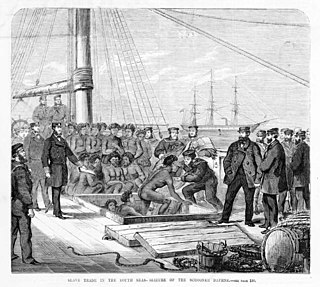
Blackbirding involves the coercion of people through deception and/or kidnapping to work as unpaid or poorly paid labourers in countries distant to their native land. The term has been most commonly applied to the large-scale taking of people indigenous to the numerous islands in the Pacific Ocean during the 19th and 20th centuries. These blackbirded people were called Kanakas or South Sea Islanders. The owners, captains and crew of the ships involved in the acquisition of these labourers were termed blackbirders. The demand for this kind of cheap labour principally came from European colonists in New South Wales, Peru, Queensland, Samoa, New Caledonia, Fiji, Tahiti, Hawaii, Mexico and Guatemala. Labouring on sugarcane, cotton and coffee plantations in these lands was the main usage of blackbirded labour, but they were also exploited in other industries.

The Bank of New South Wales (BNSW), also known commonly as The Wales, was the first bank in Australia, being established in Sydney in 1817 and situated on Broadway. During the 19th century, the Bank opened branches throughout Australia and New Zealand, expanding into Oceania in the 20th century. It merged with many other financial institutions, finally merging with the Commercial Bank of Australia in 1982 to form the Westpac Banking Corporation.

Rail transport in Australia is a crucial aspect of the Australian transport network. Rail in Australia is to a large extent state-based. As at 2018, the Australian rail network consisted of a total of 36,064 kilometres (22,409 mi) of track on three major track gauges.

Smithy is a 1946 Australian adventure film about pioneering Australian aviator Sir Charles Kingsford Smith and his 1928 flight across the Pacific Ocean, from San Francisco, California, United States to Brisbane, Queensland, Australia. This was the first-ever transpacific flight. Kingsford Smith was the pilot of the Fokker F.VII/3m three-engine monoplane "Southern Cross", with Australian aviator Charles Ulm as the relief pilot. The other two crew members were Americans James Warner and Harry Lyon.
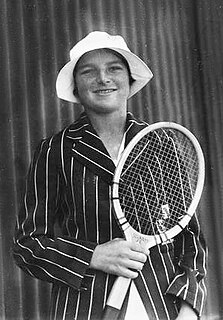
Thelma Dorothy Coyne Long was an Australian tennis player and one of the female players who dominated Australian tennis from the mid-1930s to the 1950s. During her career she won 19 Grand Slam tournament titles. In 2013 Long was inducted into the International Tennis Hall of Fame.

Joan Marcia Bathurst was an Australian Champion tennis player.
Lacrosse in Australia is a minor sport, with a long and proud history dating back to 1876, with a small but dedicated community of participants and volunteers. The established centres for Lacrosse are in the greater metropolitan areas of Melbourne, Adelaide, and Perth. In these cities there are organised weekend field lacrosse competitions for men and women at senior and junior levels, played over the winter months. In the off-season, there are informal box lacrosse and sofcrosse competitions, though the majority of players in Australia are mostly of the field lacrosse type. Some lacrosse is also played in Sydney, Newcastle, South East Queensland, Canberra and Hobart, it is very much at the developmental level.

The Kyarra was a 6,953 ton steel cargo and passenger luxury liner, built in Scotland in 1903 for the Australian United Steam Navigation Company.

Rail gauges in Australia display significant variations, which has presented an extremely difficult problem for rail transport on the Australian continent for over 150 years. As of 2014, there is 11,801 kilometres (7,333 mi) of narrow-gauge railways, 17,381 kilometres (10,800 mi) of standard gauge railways and 3,221 kilometres (2,001 mi) of broad gauge railways.

A coffee palace was an often large and elaborate residential hotel that did not serve alcohol, most of which were built in Australia in the late 19th century.

John James Clark, an Australian architect, was born in Liverpool, England. Clark's 30 years in public service, in combination with 33 in private practice, produced some of Australia's most notable public buildings, as well as at least one prominent building in New Zealand.
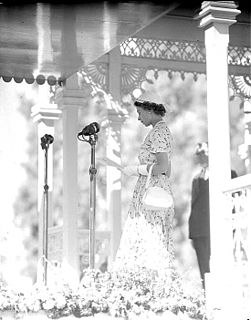
Since 1867, there have been over fifty visits by a member of the Royal Family to Australia, though only six of those came before 1954. Elizabeth II is the only reigning monarch of Australia to have set foot on Australian soil; she first did so on 3 February 1954. She was only 27 when she visited Bendigo. During her sixteen journeys the Queen has visited every Australian state and the two major territories.
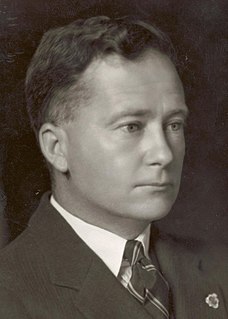
Sir Thomas Walter White, was an Australian politician and First World War pilot. In 1914 he became one of the first airmen trained for the Australian Flying Corps (AFC), and the following year was among the first AFC members to see action when he was deployed to the Middle East with the Mesopotamian Half Flight. After carrying out several missions behind Turkish lines, he was captured in November 1915 but escaped in July 1918. White was awarded the Distinguished Flying Cross and twice mentioned in despatches for his war service. He married Vera Deakin, a Red Cross worker and daughter of former Australian Prime Minister Alfred Deakin, in 1920.
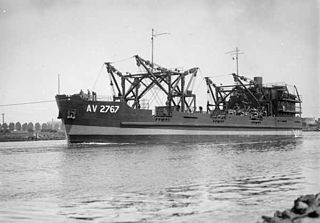
Crusader (AV2767) was an Australian Army amphibious operations support ship of World War II. She was launched shortly before the war ended and entered service in late 1945. From 1945 to 1947 she was mainly used to return Australian Army equipment from the islands off New Guinea. She was also loaned to the Australian Shipping Board in early 1947 and transported earth moving equipment and timber between Melbourne and Tasmania. However, the Army did not need a ship with Crusader's capabilities after the war, and she was sold in 1947 to the Queensland Cement and Lime Company which operated her as a coral barge on the Brisbane River until the mid-1980s. The ship was scuttled in 1986 and became a popular dive wreck.

Anne Summers AO is an Australian writer and columnist, best known as a leading feminist, editor and publisher. She was formerly First Assistant Secretary of the Office of the Status of Women in the Department of the Prime Minister and Cabinet.

Bernard Bede (Barney) Kieran was an Australian swimmer. During the course of his swimming career, he set several world records and earned many medals. A memorial was created at his grave in his honour and a swimming race was named after him.

The MLC Building is a landmark modernist skyscraper in the central business district of North Sydney, on a block bounded by Miller Street, Denison Street and Mount Street. Planned in 1954 and completed in 1957, the complex was designed in the modernist Post-war International style by architects, Bates, Smart & McCutcheon. Its completion marked the appearance of the first high-rise office block in North Sydney and the first use of curtain wall design. Built to provide much-needed office space for the Mutual Life & Citizens Assurance Company Limited, the building continues to be primarily-occupied by its original tenants.

Enid Elizabeth Backhouse was an Australian novelist, scriptwriter and playwright, best known for her family history Against Time and Place.
Rev. John Brown Gribble FRGS was an Australian minister of religion, noted for his missionary work among Aborigines in New South Wales, Western Australia and Queensland. His appointment in Western Australia was cancelled within a year due to hostility from squatters and others who had Aboriginal employees.

















